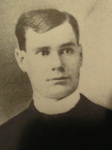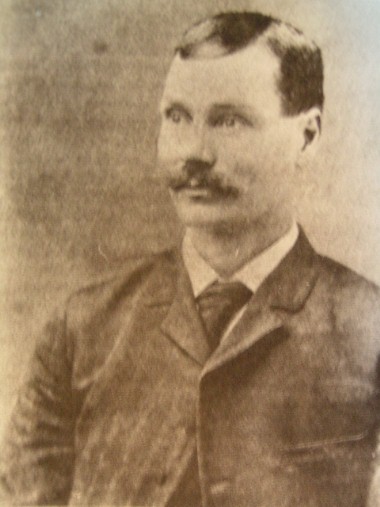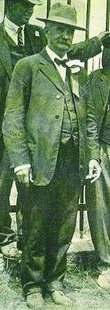On the coversheet was the title,
Custer's Last Fight
The Experience of a Private Soldier
in the Custer Massacre
by
Peter Thompson
Before me unfolded the most fascinating story I have ever read or watched. I could not put the story down. The more I read, the more I needed to keep going. As the Battle of the Little Big Horn took place before me, I was transformed. I listened to the words of Peter Thompson and I understood him, and I understood the Battle, for I was there.
As a child I visited the Battlefield and took in one of the re-enactments with my parents. Later in life, my wife and I took our three children, niece and nephew to Hardin to watch the re-enactment. I had visited the Battlefield one other time by myself as I passed by on the interstate highway. But I did not understand the Battle or the struggles the participants endured. Peter Thompson showed me. My life will never be the same....
Peter Thompson was born in Scotland, immigrated to the United States with his parents and settled in Pittsburgh, PA. The thought of becoming a soldier took possession of his mind.
Peter Thompson joined the Army in September 1875. Transferred to Fort Lincoln, Dakota Territory, October 1875. The same October, Company C of the 7th Cavalry arrived at Fort Lincoln. Pvt. Thompson was assigned to Co.C, and soon Captain Tom Custer, brother of General George Custer, took command of Company C. This company became the go to company for General Custer.
During the expedition of 1876, General Terry moved westward, arriving on the Little Missouri River. General Custer took Company C and others, down the river and back, 50 miles, crossing the river 34 times in little over 12 hours. On the march between O’Fallon Creek and the Powder River, Custer made a 15-mile mad dash to find a trail for the wagons to the Powder River, taking with Capt. Tom Custer and one half of Co.C and others. At the Powder River, Major Reno took Company C and others on a 9-day, 241-mile reconnaissance, meeting up with General Terry on the Yellowstone River. General Custer then moved the entire 7th Cavalry up the Rosebud and crossed over to the Little Big Horn River.
June 25, 1876, the 7th was divided into three battalions and a pack train. General Custer took command of Company C and four other companies. Custer took the east side of the river and at one point viewed the Indian village. The five troops then broke out into a gallop. Pvt. Thompson gradually was left behind in spite of all he could do to keep up with his company. Thompson stopped and then moved forward, stopped and moved forward again, stopped and moved forward again. Three times he moved forward, with natural instincts to fall back to the rear. The Custer Hill battle came to its conclusion. Thompson moved to the rear and was picked up by the Reno command, which then went into a defensive position, known as Reno’s Hill.
Early morning of the 26th, atop Reno Hill, Captain Benteen gathered thirteen troopers to stop the Indians from coming up a ravine and attacking the position. This would become known as Benteen's first charge of three made. One of the troopers was Pvt. Thompson. As the troopers got their ammo and guns ready, they learned their duty was to run up “a short hill towards the edge of the bluff and the head of the ravine”. Thompson was one of the first to reach the top of the bluff and rifle fire erupted from the warriors on the other side of the hill. A bullet shot through his right hand and arm, removing his middle finger, embedding in his elbow. A short distance from Thompson laid a wounded trooper and after another volley, Pvt. Thomas Meador, Co.H, was shot again and died.
Pvt. Thompson made his way back to find a doctor and Dr. Porter cared for his gun shot wounds. At this location there were many wounded soldiers, one was Co.C, Pvt. James Bennett. Kneeling down beside Bennett, Thompson asked, “Can I do you any service?” “Water, Thompson, Water, for God’s sake!” was the reply. Thompson then began to realize what he had to do. He gathered two canteens and a camp kettle, and made his way back to the ravine in which he was wounded. There he was stopped and questioned by his sergeant and was told he would never make it back alive. Thompson responded that since he could not carry a gun, which he gave to another trooper who needed a gun, he had to do something to help the wounded and the dying.
Thus began the water trips down to the Little Big Horn River. During his trip to gain water, Indians opened fire on the trooper as he entered the river, grazing his skull, as his daughter, Susan would later describe as a three inch furrow in his right scalp. Thompson made four trips to obtain water on that day.
2nd Lt. Winfield Edgerly, Co.D, 7th Cavalry, applied for and obtained a Medal of Honor for Private Peter Thompson. On October 5, 1878, Private Peter Thompson received the “Medal of Honor”.
The Citation: “After having voluntarily brought water to the wounded, in which effort he was shot through the head, he made two successful trips for the same purpose, notwithstanding remonstrances of his sergeant.”
This is the private, the soldier, the mettle, the hero, and the man, Peter Thompson.
Of the Men of Co.C, 7th Cavalry:
60 men and 2 officers, marched out of Ft. Lincoln.
37 men and 2 officers of Co.C died from The Battle of the Little Big Horn.
Peter Thompson, born September 1, 1853. Fifeshire, Scotland
Emigrated to the United States 1865 (1863), settled with his parents in Pittsburgh, Pennsylvania.
Enlisted in the United States Army for 5 years, September 21, 1875.
Upon enlistment was assigned to Jefferson Barracks, St . Louis, MS.
Transferred October 21, 1875 to Fort Abraham Lincoln, Dakota Territory.
Assigned to Co. C, 7th Cavalry, under Capt Tom Custer, 1st LT Calhoun and 2nd LT Harrington.
General George A. Custer took command of the 7th Cavalry, March, 1876.
Participated in the 1876 expedition to the Little Big Horn River against a large body of Indians.
Wounded in the Battle of the Little Big Horn, on Reno Hill, June 26, 1876,
Heroically, Thompson made four trips retrieving water for the wounded during the battle.
Awarded the Medal of Honor October 5, 1878
Citation;
"After having voluntarily brought water to the wounded,
in which effort he was shot through the head,
he made two successful trips for the same purpose,
notwithstanding remonstrances of his sergeant."
Participated in the Northern Cheyenne Campaign October 1878
Company C hunted and escorted Dull Knife's band of Cheyenne to Ft. Robinson.
Honorable Discharge September 20, 1880, Private of Excellent Character
Homesteaded Alzada, Montana 1890
Married September 21 1904 to Ruth Boicourt, two children, Susan and Peter Jr.
Authored the narrative, "Custer's Last Fight, The Experience of a Private in the Custer Massacre"
Died December 3, 1928, Veterans Home, Hot Springs, SD, buried at Lead, SD






